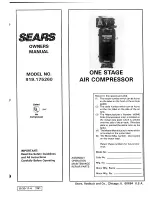
2--1
62--11052
SECTION 2
COMPRESSOR REPLACEMENT
2.1 COMPRESSOR REMOVAL
Refer to the operation and service manual covering the
equipment in which the compressor is installed for
specific removal instructions. A general removal
procedure is given below.
a. If compressor is completely inoperative, frontseat the
suction and discharge service valves to trap the
refrigerant in the unit. If the compressor will operate,
pump down the unit; then, frontseat the suction and
discharge service valves.
b. Ensure power source is removed from any controls
installed on the compressor.
c. Remove refrigerant from the compressor using a
refrigerant recovery system.
d. Disconnect refrigerant lines at service valve flange
connections on the compressor; retain hardware.
e. Remove any components necessary to gain access
to the compressor or to enable removal.
f. Disconnect the drive mechanism at the compressor.
g. Remove
mounting
hardware
and
remove
compressor from unit.
h. If compressor is to be repaired, refer to section 3 for
repair procedures. if a replacement compressor is to
be installed, refer to section 2.2 for replacement
procedures.
2.2 COMPRESSOR REPLACEMENT
Consult the unit service parts list for the correct
replacement.
Service replacement compressors are furnished
without suction and discharge service valves and
unloader valves. The service valves are normally
retained on the unit to isolate the refrigerant lines during
compressor replacement. Blank--off pads are installed
on the service replacement compressor valve flanges.
These pads must be removed prior to installing the
compressor. If the defective compressor is to be
returned for overhaul or repair, install the pads on the
compressor for sealing purposes during shipment.
Service replacement compressors are furnished with
cylinder head bypass piston plugs installed on the
unloader flanges in lieu of the unloader valves. The
unloaders (if used) must be removed from the defective
compressor and transferred to the replacement
compressor prior to installation. Refer to section 2.2.1.
If the defective compressor is to be returned for
overhaul or repair, install the plugs on the compressor
for sealing purposes during shipment.
2.2.1 Installing Compressor Unloaders
a. Remove the three socket head capscrews holding
piston plug to cylinder head of the replacement
compressor. See Figure 2-1.
1. Capscrews
2. Flange Cover
3. Gasket
4. Spring
5. Bypass Piston Plug
6. Seat Ring
7. Strainer
7
1
2
3
4
5
6
Figure 2-1. Removal of Piston Plug
b. Remove flange cover, gasket, spring, bypass piston
plug, and seat ring. A tapped hole is provided in piston
plug for use with a jackscrew to enable removal of the
plug. One of the socket head capscrews may be used
as a jackscrew.
c. Remove the three socket head capscrews holding
unloader in the cylinder head of the defective
compressor; remove the unloader and retain the
capscrews.
NOTE
Capscrews removed from the bypass piston
plug flange cover are not interchangeable with
capacity control unloader valve capscrews.
When installing the unloaders, be sure to use
the unloader capscrews.
d. Using a new gasket and unloader ring pliers (P/N
07--00223), install the unloaders in the cylinder heads
of the replacement compressor. Refer to Table 3-1,
for required torque values.
e. If the defective compressor is to be returned for
overhaul or repair, install the bypass piston plug,
spring, seat ring and flange cover onto the cylinder
heads.
Summary of Contents for 05G TWIN PORT
Page 1: ...Compressor 62 11052 Rev C WORKSHOP MANUAL for MODEL 05G TWIN PORT COMPRESSOR R...
Page 2: ......
Page 3: ...WORKSHOP MANUAL COMPRESSOR MODEL 05G TWIN PORT...
Page 4: ......
Page 14: ......
Page 26: ......
Page 28: ......
Page 29: ......
Page 30: ......
Page 31: ......
















































